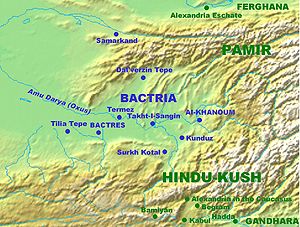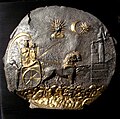Ai Khanoum
Coordinates: 37 ° 10 ′ 0 ″ N , 69 ° 24 ′ 30 ″ E

Ai Khanoum or Ay Chānom (also Ay Khanum and Ai Xanum ) is an archaeological excavation site in the Tachar province in northeastern Afghanistan . To this day it is the only extensively investigated remains of a Greek-Bactrian city. The place was founded around 145 BC. Almost completely destroyed by the invasion of nomads. Since it was abandoned afterwards and not settled again later, it is particularly well preserved in the foundation walls.
After Gholam Serwar Nasher , Khan of the Kharoti, found relics during a hunt, he commissioned the archaeologist Daniel Schlumberger to carry out the excavations. The site was eventually excavated between 1964 and 1978 by a French team led by Paul Bernard . After that there were also isolated Soviet excavations.
The town
Ai Khanoum, whose ancient name is unknown or controversial, was probably founded shortly after Alexander the Great . There are speculations that it could be Alexandria on the Oxus, known from ancient sources, and later Eukratidia . The city was about 2 km × 1.5 km in size, lies on the Oxus and is bordered in the east by a high mountain on which the so far little explored upper town is located. This mountain offers natural protection to the place. Other parts of the city have been protected by mighty ramparts. Outside the walls there was a suburb and the necropolis . There was a Greek theater and a gymnasium in the city . Both suggest that the place was organized as a typically Hellenistic polis .
For a long time the culture of the Bactrian Greeks was only known through their coinage. The excavations in Ai Khanoum confirmed the picture gained through the coins: Greco-Bactrian art was largely influenced by Greek, even if there were increasing local and Persian influences, especially in architecture, but also in local ceramic production.
A large palace building combined Greek and Persian style elements. The house had a huge courtyard with colonnades based on the Greek model. The architectural jewelry is also purely Greek with Corinthian capitals and antefixes with palmettes . A ballroom with 18 columns (3 × 6), on the other hand, seems to have followed more of the Achaemenid tradition. Many column bases are also designed in a more Persian style. A heroon from the first half of the 3rd century BC was found. BC, in which a certain Kineas was buried, who was revered as the founder of the city. A Greek inscription originally attached there lists some wisdoms of the Delphic oracle and states that a man with the Greek name Klearchos himself traveled to Delphi, copied the sayings and then had them attached to the Heroon on his return - evidence of direct contacts between the city on the Oxus and the distant Greek motherland.
Various sanctuaries could be exposed; however, none of these temples are Greek in style, which again shows strong local traditions. Greeks, Macedonians and locals probably lived in the city. All buildings stand out due to their spacious layout. In a palace and a residential building in the south of the city, the foundation walls of centrally located temple rooms with a corridor were exposed. Such common temples have also been found in other Greco-Bactrian cities in northern Afghanistan. This is one of the roots of this type of building; Another origin is the Achaemenid fire temples . Both are considered the starting point for the Cushan fire temple of Surkh Kotal , and this in turn forms the basic shape of the first Buddhist temples and the later Hindu temples .
The finds also include numerous purely Greek capitals and statues, although these were mostly made of clay due to the lack of suitable stone. In some of them, only a few details have been modeled in marble. There were further inscriptions and numerous coins, none of which dated later than Eukratides I , as well as remains of Greek papyri with previously unknown philosophical texts.
The end of the city
The end of the city is traditionally dated to around 145 BC. Dated. Nomads probably came from the northeast, probably Saks , who plundered the city and especially the palace and set fire there. The Greek residents probably fled before the attack. In recent years it has been suggested to date the events differently; according to this, Ai Khanoum is said to continue until around 50 BC. A Greek city.
In any case, soon after the Greco-Macedonian population had given up the place, locals moved into the city who had previously lived outside the earth walls. The houses were searched for anything valuable that the last residents had left behind, and the palace was razed to the earthquake. A short time later, however, attackers came again, this time probably the Yuezhi and looted the city again. The place remained uninhabited from now on; only the citadel was still inhabited until the Middle Ages.
Finds from Ai Khanoum
Statue of Heracles
Metal relief with image of the Cybele
literature
- Jochen Althoff, Jürgen Zeller (ed.): The words of the seven wise men. Greek and German. Scientific Book Society, Darmstadt 2006, ISBN 978-3-534-19505-3 .
- Fredrik Hiebert, Pierre Cambon (Ed.): Afghanistan. Hidden Treasures from the National Museum, Kabul. National Geographic, Washington DC 2008.
- Frank L. Holt: When did the Greeks abandon Ai Khanoum? . In: Anabasis. Volume 3, 2012, pp. 161-172.
- Jeffrey D. Lerner: Correcting the Early History of Ây Kânom. In: Archaeological communications from Iran and Turan. Volume 35/36, 2003/2004, pp. 373-410.
- Jeffrey D. Lerner: Revising the Chronologies of the Hellenistic Colonies of Samarkand-Marakanda (Afrasiab II-III) and Aï Khanoum (Northeastern Afghanistan). In: Anabasis. Volume 1, 2010, pp. 58-79.
- Rachel Mairs: The Hellenistic Far East. Archaelogy, Language, and Identity in Greek Central Asia. University of California Press, Berkeley 2014, ISBN 978-0-520-28127-1 .
- Margherita Isnardi Parente: Il papiro filosofico di Aï Khanoum. In: Studi su codici e papiri filosofici. Plato, Aristotle, Ierocle. Olschki, Florenz 1992, ISBN 88-222-4005-7 , pp. 169-188.
- Boris J. Stawiskij: The peoples of Central Asia in the light of their art monuments. Keil, Bonn 1982, ISBN 3-921591-23-6 , pp. 42-48.
- Excavation reports
- Paul Bernard: Première campagne de fouilles à Ai Khanoum. In: Comptes rendus des séances de l'Académie des Inscriptions et Belles-Lettres. Volume 110, 1966, pp. 127-133 ( online ).
- Paul Bernard: Deuxième campagne de fouilles à Ai Khanoum en Bactriane. In: Comptes rendus des séances de l'Académie des Inscriptions et Belles-Lettres. Volume 111, 1967, pp. 306-324 ( online ).
- Paul Bernard: Troisième campagne de fouilles à Ai Khanoum en Bactriane. In: Comptes rendus des séances de l'Académie des Inscriptions et Belles-Lettres. Volume 112, 1968, pp. 263-279 ( online ).
- Paul Bernard: Quatrième campagne de fouilles à Ai Khanoum (Bactriane). In: Comptes rendus des séances de l'Académie des Inscriptions et Belles-Lettres. Volume 113, 1969, pp. 313-354 ( online ).
- Paul Bernard: Campagne de fouilles 1969 à Ai Khanoum (Afghanistan). In: Comptes rendus des séances de l'Académie des Inscriptions et Belles-Lettres. Volume 114, 1970, pp. 301-349 ( online ).
- Paul Bernard: La campagne de fouilles de 1970 à Ai Khanoum (Afghanistan). In: Comptes rendus des séances de l'Académie des Inscriptions et Belles-Lettres. Volume 115, 1971, pp. 385-452 ( online ).
- Paul Bernard: Campagne de fouilles à Ai Khanoum (Afghanistan). In: Comptes rendus des séances de l'Académie des Inscriptions et Belles-Lettres. Volume 116, 1972, pp. 605-632 ( online ).
- Paul Bernard: Fouilles de Ai Khanoum (Afghanistan). Campagnes de 1972 et 1973. In: Comptes rendus des séances de l'Académie des Inscriptions et Belles-Lettres. Volume 118, 1974, pp. 280-308 ( online ).
- Paul Bernard: Campagne de fouilles 1974 à Ai Khanoum (Afghanistan). In: Comptes rendus des séances de l'Académie des Inscriptions et Belles-Lettres. Volume 119, 1975, pp. 167-197 ( online ).
- Paul Bernard: Campagne de fouilles 1975 à Ai Khanoum (Afghanistan). In: Comptes rendus des séances de l'Académie des Inscriptions et Belles-Lettres. Volume 120, 1976, pp. 287-322 ( online ).
- Paul Bernard: Campagne de fouilles 1976-1977 à Ai Khanoum (Afghanistan). In: Comptes rendus des séances de l'Académie des Inscriptions et Belles-Lettres. Vol. 122, 1978, pp. 421-463 ( online ).
- Paul Bernard: Campagne de fouilles 1978 à Ai Khanoum (Afghanistan). In: Comptes rendus des séances de l'Académie des Inscriptions et Belles-Lettres. Volume 124, 1980, pp. 435-459 ( online ).
- Paul Bernard: Campagnes 1965, 1966, 1967, 1968. Rapport préliminaire (= Fouilles d'Ai Khanoum. Volume 1). Klincksieck, Paris 1973, ISBN 2-252-01420-2 .
- Olivier Guillaume: Les propylées de la rue principale (= Fouilles d'Ai Khanoum. Volume 2). Boccard, Paris 1983.
- Henri-Paul Francfort: Le sanctuaire du temple à niches indentées (= Fouilles d'Ai Khanoum. Volume 3). Boccard, Paris 1984.
- Paul Bernard: Les monnaies hors trésors. Questions d'histoire Gréco-Bactrienne (= Fouilles d'Ai Khanoum. Volume 4). Boccard, Paris 1985.
- Pierre Leriche: Les remparts et les monuments associés (= Fouilles d'Ai Khanoum. Volume 5). Boccard, Paris 1986.
- Serge Veuve: Le Gymnase. Architecture, céramique, sculpture (= Fouilles d'Ai Khanoum. Volume 6). Boccard, Paris 1987.
- Olivier Guillaume: Les petits objets (= Fouilles d'Ai Khanoum. Volume 7). Boccard, Paris 1987.
- Claude Rapin: La trésorerie du palais hellénistique d'Ai Khanoum (= Fouilles d'Ai Khanoum. Volume 8). Boccard, Paris 1992, ISBN 2-9506459-0-9 .
- Guy Lecuyot: L'habitat (= Fouilles d'Ai Khanoum. Volume 9). Boccard, Paris 2013, ISBN 978-2-7018-0348-7 .
Web links
- Afghanistan - Hidden Treasures (slide shows with audio commentary, including about Ai Khanoum on National Geographic Online, English)
- Afghanistan - Hidden Treasures - Burial sites (additional data for Google Earth, in order to be able to view Ai Khanoum in detail)
- Abdul Wasey Feroozi: The Impact of War upon Afghanistan's Cultural Heritage (PDF, 8.8 MB; contains description, photos and plans)
- O. Bernard: ĀY ḴĀNOM . In: Ehsan Yarshater (Ed.): Encyclopædia Iranica (English, including references)
- Jona Lendering: Alexandria on the Oxus (Ai Khanum) . In: Livius.org (English)
Remarks
- ↑ Composed of the Turanic word Ay for moon as a symbol of beauty and the word Persian خانم, actually means "lady of the house with a moon face". In Uzbek means Persian آی خانم literally “moon lady”, means a “beautiful princess”.
- ↑ For a detailed description of the city and its buildings see Rachel Mairs: The Hellenistic Far East. Berkeley 2014, pp. 57-101.
- ↑ "Be decent as a child / controlled as a young person / fair as an adult / reasonable as an old man / die without grief". Cf. Jochen Althoff, Dieter Zeller (ed.): The words of the seven wise men. Darmstadt 2006, p. 60.
- ↑ "Ανδρῶν τοι σοΦὰ ταῦτα παλαιοτέρων ἀνάκειται / ῥήματα ἀριγνώντων Πυθοῖ ἐν ἠγαθέαι / ἔνθεν ταῦτα Κλέαρχος ἐπιφραδέως ἀναγράψας / ἕισατο τηλαυγῆ Κινέου ἐν τεμένει". ("These wise words of even old, well-known men are consecrated in the most holy Pytho; / From there, Klearchus wrote this down expertly / and placed it radiantly in the grove of Kineas"). Epigram and translation: Jochen Althoff, Dieter Zeller (ed.): The words of the seven wise men. Darmstadt 2006, p. 59f.
- ↑ discussion on the case of Ai Khanoums in Rachel Mairs: The Hellenistic Far East. Berkeley 2014, pp. 170-173.
- ↑ For the discussion, see Frank L. Holt: When did the Greeks abandon Ai Khanoum? . In: Anabasis. Volume 3, 2012, pp. 161-172.
- ^ Paul Bernard: The Greek Colony at Ai Kanum and Hellenism in Central Asia. In: Friedrik Hiebert, Pierre Cambon (Ed.): Afghanistan. Hidden Treasures from the National Museum, Kabul. National Geographic Society, Washington 2008, ISBN 978-1-4262-0295-7 , p. 104.













